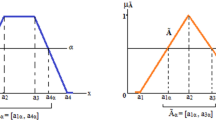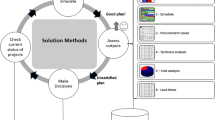Abstract
Project management is a very important field employed for scheduling activities and monitoring the progress, in competitive and fluctuating environments. The feasible duration time required to perform a specific project is determined using critical path method. However, because of competitive priorities, time is important and the completion time of a project determined using critical path method should be reduced to meet a deadline requested. In this situation, project crashing problem arises. Project crashing analysis is concerned with shortening the project duration time by accelerating some of its activities at an additional cost. In general, the parameters of the problem are accepted as certain and the project crashing problems are solved using deterministic solution techniques. In reality, because of uncertain environment conditions, incomplete or unobtainable information, there can be ambiguity in the parameters of the problem. The uncertainty in the parameters can be modeled via fuzzy set theory. Using fuzzy models gives the chance of better project management decisions with more stability under uncertain environmental factors. In the literature, various authors solved different fuzzy versions of project management problems via transforming them into their crisp equivalents. In this study, a fuzzy multi-objective project crashing problem with fuzzy parameters is handled. The fuzzy project crashing problem is solved with a direct solution approach based on fuzzy ranking methods and the tabu search algorithm.



Similar content being viewed by others
References
Chen SH, Tsai MJ (2011) Time-cost trade-off analysis of project networks in fuzzy environments. Eur J Oper Res 212:386–397
Lin FT (2008) Fuzzy crashing problem on project management based on confidence-interval estimates. Eight Int Conf Intell Syst Des Appl 2:164–169
Ma W, Ke H (2009) Modeling time-cost trade-off problem with fuzzy activity duration times. Fourth Int Conf Coop Promot Inf Res Sci Technol 21–23:344–347
Leu SS, Chen AT, Yang CH (2001) A GA-based fuzzy optimal model for construction time-cost trade-off. Int J Proj Manag 19:47–58
Liang TF (2009) Application of fuzzy sets to multi-objective project management decisions. Int J Gen Syst 38:311–330
McCahon CS (1993) Using PERT as an approximation of fuzzy project-network analysis. IEEE Trans Eng Manag 40:146–153
Liu ST (2003) Fuzzy activity times in critical path and project crashing problems. Cybern Syst Int J 34:161–172
Arıkan F, Güngör Z (2001) An application of fuzzy goal programming to a multiobjective project network problem. Fuzzy Sets Syst 119:49–58
Wang RC, Liang TF (2004) Project management decisions with multiple fuzzy goals. Constr Manag Econ 22:1047–1056
Bellman RE, Zadeh LA (1970) Decision-making in a fuzzy environment. Manag Sci 17:141–164
Eshtehardian E, Afshar A, Abbasnia R (2008) Time-cost optimization: using GA and fuzzy sets theory for uncertainties in cost. Constr Manag Econ 26:679–691
Eshtehardian E, Afshar A, Abbasnia R (2009) Fuzzy-based MOGA approach to stochastic time-cost trade-off problem. Autom Constr 18:692–701
Ghazanfari M, Yousefli A, Jabal Ameli MS, Bozorgi-Amiri A (2009) A new approach to solve time-cost trade-off problem with fuzzy decision variables. Int J Adv Manuf Technol 42:408–414
Liang TF (2010) Applying fuzzy goal programming to project management decisions with multiple goals in uncertain environments. Expert Syst Appl 37:8499–8507
Bector CR, Chandra S (2005) Fuzzy mathematical programming and fuzzy matrix games, Studies in fuzziness and soft computing Volume 169. Springer, Berlin Heidelberg
Zadeh LA (1965) Fuzzy sets. Inf Control 8:338–353
Klir GJ, Yuan B (1995) Fuzzy sets and fuzzy logic: theory and applications. Prentice Hall PTR, USA
Buckley JJ, Eslami E, Feuring T (2002) Fuzzy mathematics in economics and engineering. Physica-Verlag, Heidelberg
Chen SJ, Hwang CL (1992) Fuzzy multiple attribute decision making methods and applications. Springer, Berlin Heidelberg
Wang X, Kerre EE (2001) Reasonable properties for the ordering of fuzzy quantities (I). Fuzzy Sets Syst 118:375–385
Yao JS, Wu K (2000) Ranking fuzzy numbers based on decomposition principle and signed distance. Fuzzy Sets Syst 116:275–288
Chen SJ, Chen SM (2003) A new method for handling multicriteria fuzzy decision making problems using FN_IOWA operators. Cybern Syst Int J 34:109–137
Glover F (1990) Tabu search: a tutorial. Interfaces 20:74–94
Glover F (1993) A user’s guide to Tabu search. Ann Oper Res 41:3–28
Baykasoglu A, Göçken T (2010) Multi-objective aggregate production planning with fuzzy parameters. Adv Eng Softw 41:1124–1131
Baykasoglu A, Owen S, Gindy N (1999) Solution of goal programming models using a basic taboo search algorithm. J Oper Res Soc 50:960–973
Baykasoglu A, Owen S, Gindy N (1999) A taboo search based approach to find the Pareto optimal set in multiple objective optimization. Eng Opt 31:731–748
Baykasoglu A, Göçken T (2008) A review and classification of fuzzy mathematical programs. J Intell Fuzzy Syst 19:205–229
Zimmermann H (1976) Description and optimization of fuzzy systems. Int J Gen Syst 2:209–215
Tanaka H, Asai K (1984) Fuzzy solution in fuzzy linear programming problems. IEEE Trans Syst Man Cybern SMC-14:325–328
Campos L, Verdegay JL (1989) Linear programming problems and ranking of fuzzy numbers. Fuzzy Sets Syst 32:1–11
Nakahara Y (1998) User oriented ranking criteria and its application to fuzzy mathematical programming problems. Fuzzy Sets Syst 94:275–286
Cadenas JM, Verdegay JL (2000) Using ranking functions in multiobjective fuzzy linear programming. Fuzzy Sets Syst 111:47–53
Baykasoğlu A, Göçken T (2007) Solution of a fully fuzzy multi-item economic order quantity problem by using fuzzy ranking functions. Eng Optim 39:919–939
Author information
Authors and Affiliations
Corresponding author
Rights and permissions
About this article
Cite this article
Göçken, T. Solution of fuzzy multi-objective project crashing problem. Neural Comput & Applic 23, 2167–2175 (2013). https://doi.org/10.1007/s00521-012-1167-z
Received:
Accepted:
Published:
Issue Date:
DOI: https://doi.org/10.1007/s00521-012-1167-z




